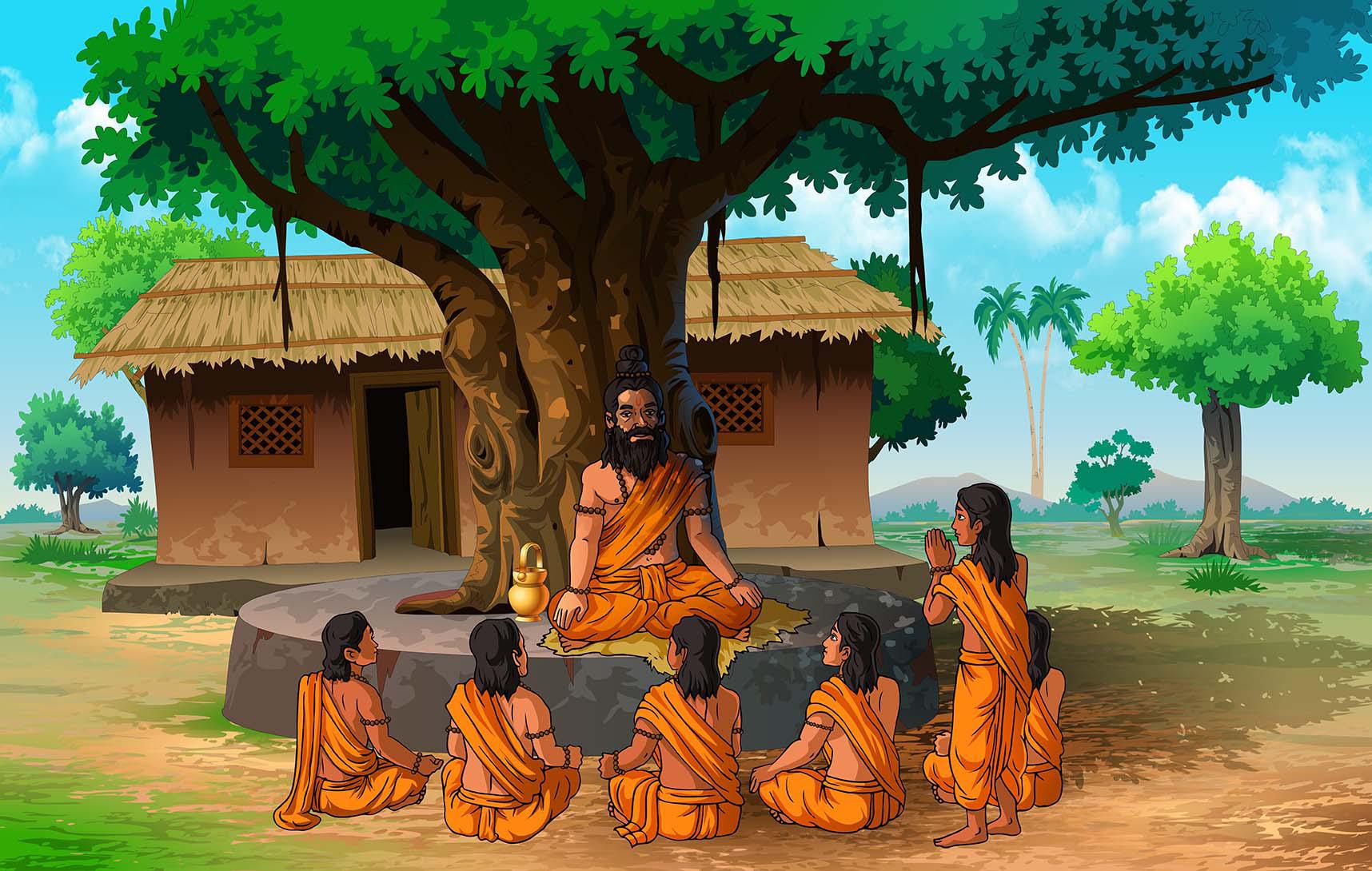Upanishad (upa-nishad, 'near-sitting'), a class of works embodying the mystical and esoteric doctrines of ancient Hindu philosophy, and believed to be so named because they were discourses delivered to chosen pupils who were permitted to 'sit near' their gurus (preceptors) to receive the sacred teaching.
The Chhandogya Upanishad relates that the Vedic god Indra came as a student to acquaint himself with the knowledge of Brahma, and was able to grasp the sophisticated doctrines only with considerable difficulty.
They are later in date than the older Samhitas and Brahmanas, although they constitute part of the Brahmanas or are embodied in the Aranyakas.
The Upanishads present not one but several doctrines. The lesser Upanishads cover many systems of thought and reflect a wide variety of beliefs and superstitions. But the major Upanishads deal with some of the great problems which have vexed man from time immemorial: the nature of God and the soul, of man and the world, and the relation between them; the nature and purpose of existence; the ultimate reality and its nature; the attainment of salvation by man.
There are about 150 'major' Upanishads, but 108 is the traditional recognized number of the texts. They vary greatly in length; the Isa would occupy a single printed page, the Brihadaranyaka Upanishad at least fifty pages. The five, seven, ten or thirteen `principal' Upanishads are generally chosen from those named here.
The Rig-Vedic Upanishads are: a) Aiteraya (i.e. the Aitareya Upanishad), so called from its inclusion in the Aitareya Brahmana. An Upanishad written in prose, expressing Vedantic ideas, and discussing the question of the self and Brahma; b) Kausitaki, forms part of the Kausitaki Aranyaka, which itself is included in the Kausitaka Brahmana of the Rig-veda. It represents one of the early Upanishads.
The Sama-Vedic Upanishads are: a) Chhandogya, early and fairly long, composed in prose with a few verses interspersed; it comprises eight chapters of the Chhandogya Brahmana. b) Kena (or Kenopanishad), an early, very brief, mixed prose and verse Upanishad, forming the tenth chapter of the Jaiminiya Brahmana.
The Yajur-Vedic Upanishads are: a) Brihadaranyaka, great forest'; an early, lengthy, prose Upanishad intermixed with verse. It forms part of the Satapatha Brahmana included in the White Yajur-veda, the last section of which represents this Upanishad. It is ascribed to the sage Yajnavalkya. b) Isha, a very short prose (except for two verses) Upanishad, forming the last (fortieth) chapter of the Vajasaneyi Samhita or the White Yajur-veda. So named because its first word is isha, Lord. It is also called the Samhitopanishad; c) Taittiriya, an early prose Upanishad, included in the Taittiriya Brahmana of the Black Yajur-veda; d) Shvetasvatara, 'white steed', comparatively late and wholly in verse. So called because it is related to the Shvetasvatara school of the Black Yajur-veda, founded by a teacher of that name. it represents a theistic treatise with Shiva as the deity of deities, and probably influenced the Vaishnavite Bhagavadgita. It is one of the basic texts of Shaivism; e) Maitrayani (or Maitri-a second text exists which is known by the latter name), included in the Maitrayani branch of the Black Yajur-veda. It is in prose with occasional verse; f) Katha, or the Kathopanishad, written in verse. It is connected with the Katha of the Black Yajur-veda. This Upanishad covers the subject of Vedanta, the nature of the Ultimate Being, and the path of Yoga.
The Atharva-Vedic Upanishads are a) Mundaka, in mixed prose and verse. Why it is so named is not clear, but possibly from a reference to the Shirovata (siras, 'head') or `head-vow', a rite in which one had to hold fire over one's shaven head, in order to become the recipient of the knowledge of Brahma taught in it. It is traditionally linked with the Atharva-veda; b) Mandukya, so called because it was revealed by the sage Manduka. It consists of only twelve verses, but is believed to contain the essence of the 108 Upanishads. Its theme is the syllable, Om; c) Prashna, in mixed prose and verse. It is so called because of the six 'questions' discussed and solved in it. It is traditionally linked with the Atharva-veda. The questions in the Prashna are solved by the rishi Pippalada, the founder of the Paippalada school of the Atharva-veda.













